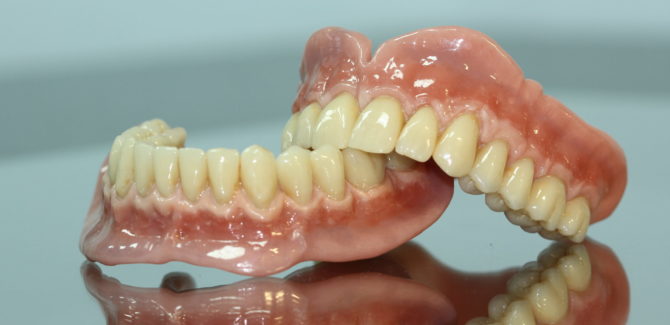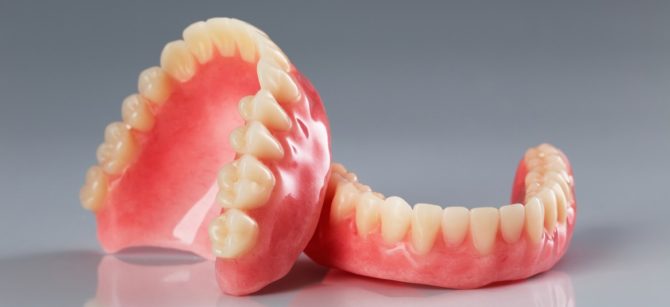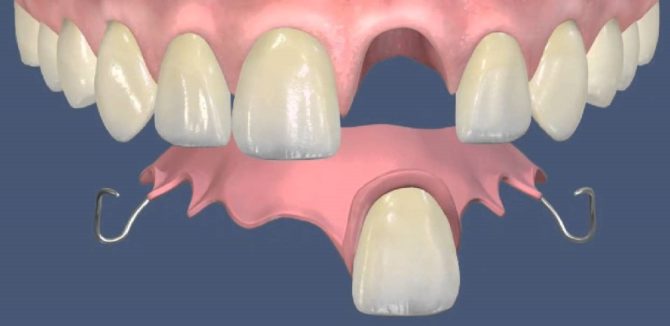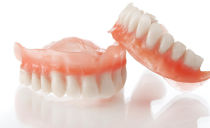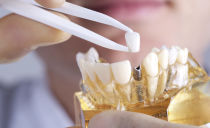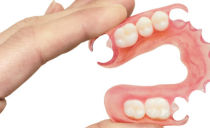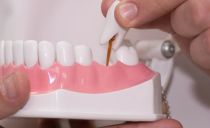Removable dentures: what is it, types, materials, how to wear
A small amount of lost teeth in modern classical dentistry is compensated by the installation of implants or bridges. In cases when gaps in the dentition are too large, use removable dentures. These are constructions that the patient can remove and insert into the oral cavity independently, without the help of a doctor.
Content
The main categories of removable dentures
Conditionally removable dentures can be divided into two categories: for patients suffering from the loss of several teeth, and for those who have their complete absence.
Partial toothless designs
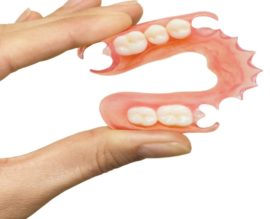 The problem of partial absence of teeth is easily resolved, since the supporting teeth were preserved in the oral cavity. They are used by the doctor for reliable fixation of the removable denture and the even distribution of the chewing load on the surface of the gums.
The problem of partial absence of teeth is easily resolved, since the supporting teeth were preserved in the oral cavity. They are used by the doctor for reliable fixation of the removable denture and the even distribution of the chewing load on the surface of the gums.
Partial dentures are made of nylon and acrylic plastic. Sometimes, taking into account the individual characteristics of a person, the degree of sensitivity of his teeth, the doctor may offer a clasp prosthesis - a removable product, the basis of which is a metal frame.
Solving problems with complete absence of teeth
The difficulty of prosthetics with full adentia is that the entire chewing load falls on the gum. From this, the alveolar processes of the jaw very quickly atrophy and cease to correspond to the given shape of the removable denture. After 2 years of wearing it, the patient begins to experience discomfort, so you have to create and install a new product.
Another problem with complete prosthetics is the fixation of the prosthesis. If the structure of the upper jaw leaves a chance to relatively reliably fix the removable prosthesis in the space allotted to it, then for the lower one mini-implants have to be made.
The process of installing mini-implants is difficult and lengthy, requires the hard work of a technician and patient patience. Materials for the manufacture of the prosthesis are standard: nylon, acrylic plastic, metal.
Materials and their features
Any removable design has pros and cons. The choice of material is determined on the basis of physiological characteristics, the state of bone tissue, the financial capabilities of the patient.
Acrylic plastic
Partial dentures and full dentures are also made from this material. In dental practice, plastic products have taken root under the name of a plate prosthesis. In terms of stiffness, they are superior to analogues of nylon, so they better protect the jaw when chewing, without causing pain.
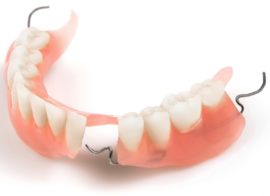 For the correction of partial adentia, removable products with the inclusion of a rigid metal wire are used. Covering the supporting teeth, she holds the structure in the oral cavity, preventing it from moving. The method has been successfully used for prosthetics on the upper and lower jaw.
For the correction of partial adentia, removable products with the inclusion of a rigid metal wire are used. Covering the supporting teeth, she holds the structure in the oral cavity, preventing it from moving. The method has been successfully used for prosthetics on the upper and lower jaw.
In the complete absence of teeth, they implement the closing valve method or, in a simple way, the effect of a suction cup. If you insert a precisely fitted acrylic prosthesis into the oral cavity and press on it, it will automatically stick to the jaw.To keep it in place will be naturally formed discharged space.
In cases where a full removable prosthesis made of plastic does not hold in place, the use of a cream that improves fixation is indicated.
Special cases
Acrylic removable dentures are suitable for installation on teeth in need of strengthening the roots. In this situation, dentists regard the prosthesis as splinting - not allowing loose teeth to fall out. Often, plastic products are used for removable prosthetics of one tooth to achieve an aesthetic effect.
It happens that as a result of wearing a removable acrylic plate on the upper jaw, the sensitivity of the teeth to temperature decreases: cold drink, hot dishes. Then the patient is advised to exercise caution or replace the prosthesis with a structure made of another material.
Life time
The time during which the removable plastic prosthesis will function correctly is limited to two to three years. The maximum service life of acrylic structures is five years. It is worth remembering that the product becomes unusable not because of the fragility of the material, but due to atrophy of bone tissue. Therefore, it is not comfortable to wear the plate after this time.
Nylon
Like the previous material, nylon is suitable for the manufacture of partial and complete removable dentures. Products from it are flexible and lightweight, therefore more convenient. Speaking as the only clasp mount, they are also made of nylon, unlike the metal elements of plastic structures. They are almost invisible or do not stand out against the background of the gums.
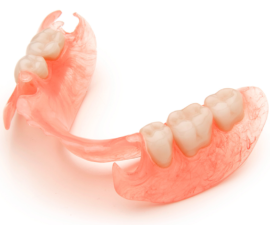 Not everyone likes to wear soft nylon dentures; patients often complain about their rough surface and soreness when chewing solid food. To these complaints, you can add the observations of dentists who note such drawbacks of nylon structures as:
Not everyone likes to wear soft nylon dentures; patients often complain about their rough surface and soreness when chewing solid food. To these complaints, you can add the observations of dentists who note such drawbacks of nylon structures as:
- accelerated atrophy of the jaw bones;
- short shelf life and the need for regular correction;
- quick change of the original shape of the product.
All this makes dental prosthetics using nylon a good option for reconstructing the smile zone, but durable acrylic dentures are better for replacing chewing teeth.
Metal
Clasp prosthesis with a rigid metal frame will be even more reliable. Strengthening the structure many times, it allows to reduce the basis:
- on the upper jaw - abandon the plate covering the sky;
- on the bottom - to do without the massive part in the hyoid space.
Replacing thick plastic or nylon elements with thin metal arcs facilitates articulation and makes eating more comfortable.
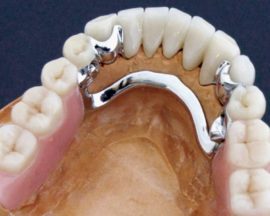 Clasp clasps are removable in two ways: using clasps and micro locks. The first type of attachment is a metal branch enveloping the abutment tooth, the second is a more complex system, which is implemented as follows:
Clasp clasps are removable in two ways: using clasps and micro locks. The first type of attachment is a metal branch enveloping the abutment tooth, the second is a more complex system, which is implemented as follows:
- Ceramic-metal crowns with halves of a miniature locking device are placed on supporting teeth.
- The second halves of the castle are mounted on the prosthesis itself.
To put on the product, the patient connects the locking elements on the crowns with their halves on the prosthesis. The lock closes and the structure is securely locked.
Of all types of removable dentures, clasp ones are the most reliable; they are comfortable to wear and easy to put on. However, they are also the most expensive, especially those made using micro locks.
Innovation: Acry-free plastic
Based on the classic acrylic plastic, Israeli scientists have removed from its composition a monomer called methyl methacrylate. The result is a material that is a cross between solid acrylic and ductile nylon. In fact, he combined their best qualities, making it possible to make removable structures reliable, like acrylic and elastic, like nylon.
Highly appreciated and the aesthetic characteristics of Acre-free. The fixing element of these prostheses has the same shade as the main part.
While the technology is new, the price of Acry-free dentures remains high. A full denture on one jaw will cost at least 50 thousand rubles.
How to wear removable dentures
After the doctor chooses a correction method, and the technician makes a suitable design, the patient will have to go through an adaptation period. In some, it passes quickly and painlessly, others experience constant discomfort from the presence of a foreign object in the mouth, while others note the occurrence of pain.
Doctors say that, despite all the advantages and disadvantages of the chosen method of prosthetics, the mood of a person plays a big role in addiction. Those patients who seek to adapt as quickly as possible to new circumstances undergo adaptation easier.
What to do if it hurts
If pain occurs:
- Accurately determine all places of localization of pain. For this, the prosthesis must be carried at least five hours in a row.
- Refuse attempts to “fit” the product yourself. Any unprofessional interference will make the design unsuitable for further wearing.
- Examine the mucosa for the onset of inflammatory processes. Sores, redness and abscesses are clearly visible in the mirror in bright light.
At the next visit (planned or urgent), you should share your observations with the doctor, voice all complaints that have arisen, and ask exciting questions.
How to smooth discomfort
Observe the simple rules of operation of the prosthesis to help reduce the period of addiction and facilitate it:
- It is necessary to carefully observe hygiene: use pastes, brushes, disinfectant rinses, natural antiseptics - decoctions of herbs.
- It is necessary to observe the mode of wearing the design: to wear in the morning and take off all night.
- The use of specialized fixing compounds is recommended.
In the first weeks of wearing prostheses, many patients complain of impaired diction. To speed up the process of normalization, it is recommended to read aloud daily. Reading will help restore full articulation and get used to new sensations in the shortest possible time.
Denture Care
Regardless of what removable dentures are made of, care is needed for them, which consists in cleaning, prevention and timely repair. For the orthodontic design to serve for a long time, it is necessary:
- In addition to morning and evening cleaning, rinse the product several times during the day with clean water.
- Use high-quality disinfectants.
- Eliminate the possibility of aggressive chemical or mechanical effects on the prosthesis (it is recommended to clean and treat the structure over a soft cloth, towel).
- Cracks, abrasions, and other defects that have arisen should be leveled only with the help of an orthodontist.
Attention! Not every disinfectant solution can leave the prosthesis all night. Modern drugs cope with the mission assigned to them, on average, in 30 minutes. A longer stay of the prosthesis in solution can have a detrimental effect on sensitive structural elements. Information on the optimal treatment period can be found in the instructions for the drug.
How to choose the perfect prosthesis
In order for the orthodontic construction to be considered ideal, it must have three properties:
- natural appearance;
- convenience;
- durability.
A triple effect can only be achieved if the doctor and patient work in tandem. The doctor needs professionalism, the patient is required to follow the recommendations and complete trust in the doctor. Therefore, it is worthwhile to approach the choice of clinic and specialist with responsibility.

